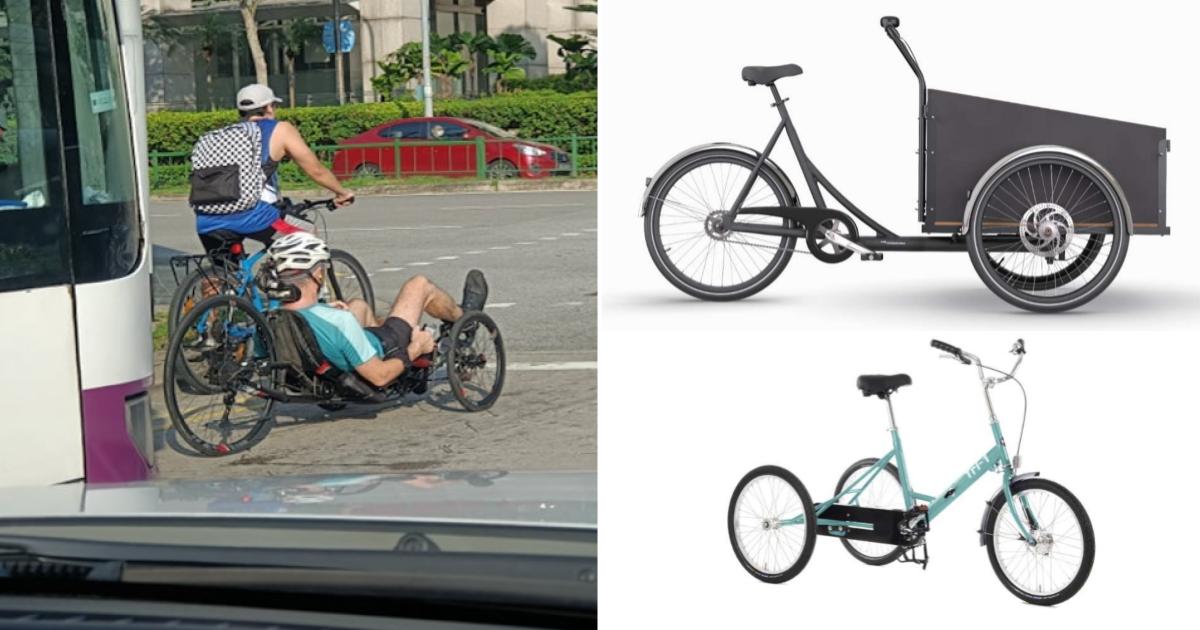Follow us on Telegram for the latest updates: https://t.me/mothershipsg
A government-appointed panel has recommended that more types of vehicles be allowed on the roads in Singapore, and these recommendations have been accepted by the Ministry of Transport (MOT).
Thus, the following vehicle types will soon be allowed on both paths and roads:
- Cargo tricycles
- Rider-only tricycles
- Recumbent tricycles
Previously, only cargo bicycles and two-wheeled recumbents were allowed on paths and roads, while rider-only tricycles and three-wheeled recumbents were confined to paths only.
MOT said on Mar. 3 that these devices are useful as they can be used by people with specific needs.
For example, recumbents can be used by those with mobility challenges or back conditions, and cargo and rider-only tricycles are also safer for seniors with issues balancing, as they provide more stability, said the ministry.
MOT will also implement new regulations for the use of such devices, aimed at ensuring the devices are used safely and responsibly.
However, motorised versions of such devices will continue to be disallowed, said MOT, adding that it would "review this again when recognised international standards are available".
Criteria for devices on paths and roads
MOT is also accepting recommendations from the Active Mobility Advisory Panel (AMAP) to implement a set of updated criteria for active mobility devices to be used on both paths and roads.
On paths
Non-motorised cargo bicycles, cargo tricycles, rider-only tricycles and recumbents should be subject to existing requirements for devices (devices must not be larger than 70cm in width and must not be heavier than 20kg in unladen weight), when ridden on paths.
MOT said this is to enable users of all active mobility devices to keep a safe distance when passing or overtaking each other, and to reduce the risk of severe injuries in an accident.
On roads
MOT noted that cargo bicycles, cargo tricycles, rider-only tricycles, and recumbents may come in larger sizes, and that they are less manoeuvrable, slower moving and more difficult to overtake on roads.
Thus, when used on roads, they will be subject to new requirements for width and length.
For consistency, these new criteria will be extended to all active mobility devices that are permitted for use on roads, including conventional bicycles, said MOT.
Here are the limits for all devices being used on roads:
- Maximum of 1.3m in width (taking reference from the width of a trishaw)
- Maximum of 2.6m in length (taking reference from the length of a two-seater tandem bicycle)
"These requirements would prevent the overall proliferation of overly wide or long devices on roads, which could potentially cause road congestion and safety risks," the ministry added.
There will also be a requirement for recumbent bicycles being used on the road to be installed with a bright-coloured flag on a pole of a "reasonable height" for increased visibility to other road users.
Carrying passengers
The new vehicle types being allowed on roads will also be allowed to carry passengers.
However, they must be equipped with a properly constructed seat or carrier (if the passenger is a child below 12 years of age), or a seat designed for passengers.
This is in line with current rules for the carriage of passengers on conventional bicycles on paths and roads.
Bicycle trailers
MOT also accepted AMAP's recommendation for bicycle trailers to continue to be allowed on footpaths and cycling paths, while remaining disallowed on roads.
On paths, the weight and width criteria will apply (up to 70cm in width and up to 20kg in unladen weight).
As for use on roads, MOT said bicycle trailers have a higher risk of tipping over when towed, and this could be hazardous to the user and other motorists.
MOT said the government would raise awareness of the new rules through public education and outreach efforts, adding:
"We encourage all active mobility users, pedestrians and motorists to continue to play their part by sharing paths and roads safely and graciously. We will continue to monitor developments in the active mobility landscape and ensure that our local regulations remain relevant and effective."
You can view the Active Mobility Advisory Panel (AMAP)'s report, dated Feb. 20, 2023, here.
Related stories
Top image via AMAP report and Roads.sg/Facebook
If you like what you read, follow us on Facebook, Instagram, Twitter and Telegram to get the latest updates.
